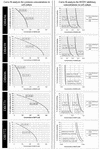Detection of inhibition of bovine viral diarrhea virus by aromatic cationic molecules
- PMID: 12821472
- PMCID: PMC161853
- DOI: 10.1128/AAC.47.7.2223-2230.2003
Detection of inhibition of bovine viral diarrhea virus by aromatic cationic molecules
Abstract
Bovine viral diarrhea virus (BVDV) is an economically significant pathogen of cattle and a problematic contaminant in the laboratory. BVDV is often used as an in vitro model for hepatitis C virus during drug discovery efforts. Aromatic dicationic molecules have exhibited inhibitory activity against several RNA viruses. Thus, the purpose of this research was to develop and apply a method for screening the aromatic cationic compounds for in vitro cytotoxicity and activity against a noncytopathic strain of BVDV. The screening method evaluated the concentration of BVDV in medium and cell lysates after 72 h of cell culture in the presence of either a 25 or 5 microM concentration of the test compound. Five of 93 screened compounds were selected for further determination of inhibitory (90 and 50%) and cytotoxic (50 and 10%) concentration endpoints. The screening method identified compounds that exhibited inhibition of BVDV at nanomolar concentrations while exhibiting no cytotoxicity at 25 microM concentrations. The leading compounds require further investigation to determine their mechanism of action, in vivo activity, and specific activity against hepatitis C virus.
Figures
References
Publication types
MeSH terms
Substances
Grants and funding
LinkOut - more resources
Full Text Sources
Other Literature Sources


